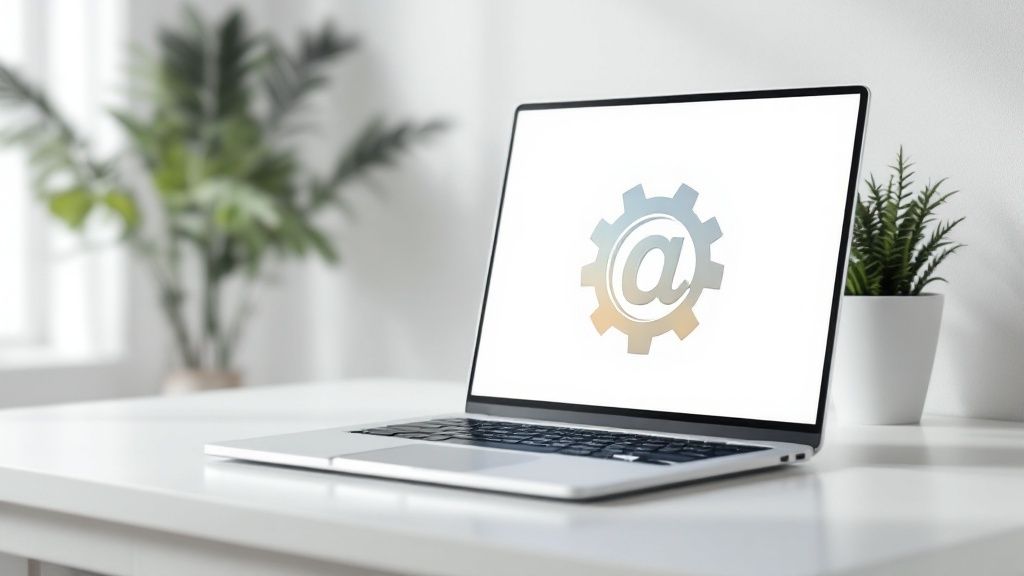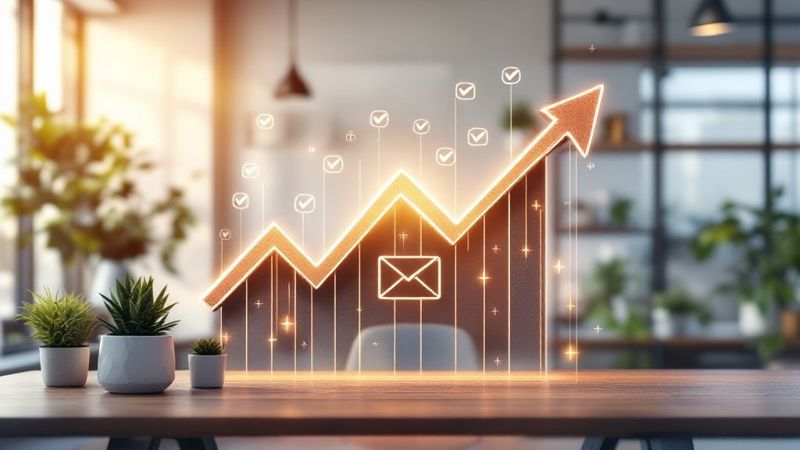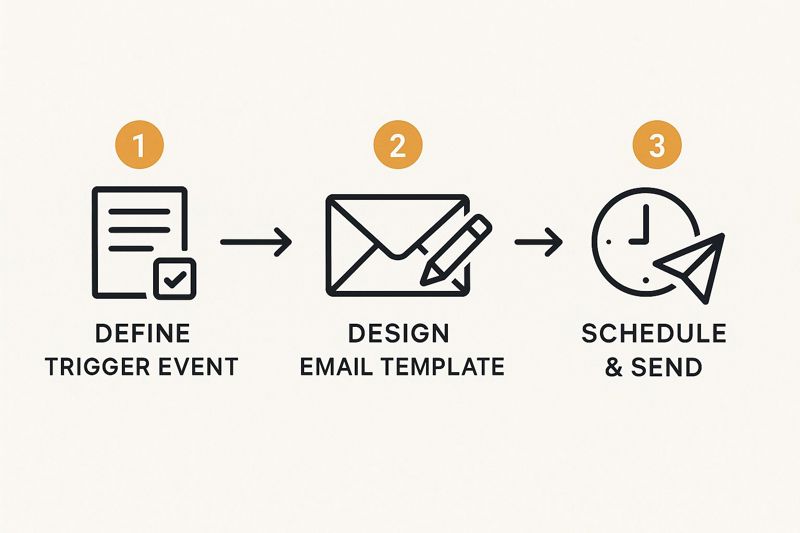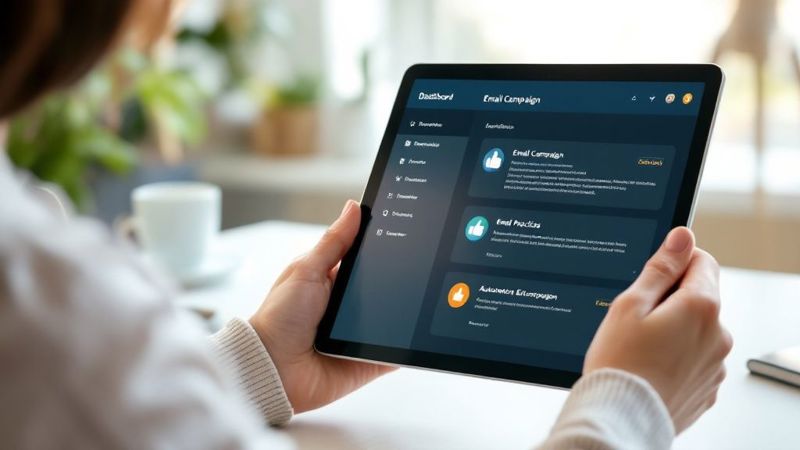Of course, sending a mass email blast has its place. But the real magic happens when you automatically send an email based on what a user actually does. This is how you shift from a generic monologue to a personal, timely conversation.
Beyond Broadcasts: The Power of Triggered Emails
Mass email campaigns are fine, but they can often feel a little impersonal, can't they? The real shift in smart digital marketing is toward triggered emails—messages sent automatically in direct response to a user's behavior. This isn't just about scheduling; it's about reacting in the moment.

This responsive approach is incredibly effective. While automated emails are just a tiny slice of the total volume sent, they punch way above their weight in terms of revenue. The data is pretty staggering: automated emails accounted for only 1.8% of all sends but drove a whopping 31% of all email-driven orders. It’s a perfect illustration of their efficiency and impact.
Why Triggered Emails Just Work Better
The secret sauce is all about relevance and timing.
When someone signs up for your newsletter, an immediate welcome email feels completely natural. It's expected. If they abandon their shopping cart, a friendly reminder an hour later is genuinely helpful, not intrusive. This is the core concept of what is email automation and why it’s so effective.
By responding to these key moments, you create a much more engaging and logical customer journey. If you want to see just how far you can take this, check out some of these powerful drip campaign examples for some fantastic inspiration.
The goal is to move from sending emails to everyone, to sending the right email to the right person at the right time. This is where true engagement begins.
Now, imagine taking this a step further. By adding dynamic, personalized images from a tool like OKZest, you can elevate this whole strategy. Think about a welcome email that has the new subscriber's name beautifully integrated into a banner image. It's a simple touch, but it makes an automated message feel like a one-on-one interaction, building genuine customer loyalty from the very first hello.
Building Your Dynamic Image Template in OKZest
Before you can start sending out those show-stopping automated emails, you need to build their visual heart. This all happens inside OKZest, where you’ll create the dynamic image template—the foundation for all your personalized visuals.
Think of it like designing a smart picture frame before you add the photo.
The first move is always to pick a great background image. This needs to vibe with your brand's look and feel. It could be a clean graphic with your logo or a high-quality lifestyle shot. The key is to create a canvas that makes the personalized text pop, not compete with it.
Adding Your Dynamic Layers
With your background in place, it’s time to add layers for your dynamic content. These are just simple text boxes that will automatically pull in unique data for each person on your list.
Here’s a peek at the OKZest interface where you’ll work your magic.

We designed the interface to be super simple. You can just drag and drop text layers and position them exactly where you want, no coding needed.
Let’s say you’re building an image for a welcome email. You might want layers for:
- First Name: This is the most common and, honestly, one of the most effective personal touches you can add.
- Company Name: A fantastic addition for B2B emails. It shows you’ve done your homework.
- Unique Offer: Something like "Your 15% Off Coupon" to grab their attention.
Each of these layers will eventually get its content from your email service provider using merge tags (we’ll get to that part soon). For now, you're just the designer. Nailing the visual here is what makes your automated messages feel like they were crafted one-by-one.
If you're looking for more ideas, check out how other businesses are using personalized images for email campaigns to get incredible results.
Pro Tip: Always, always set a fallback value for each layer. For example, if you don’t have a subscriber's first name, the image can default to something friendly like "Valued Customer" instead of leaving a weird blank space. This little trick keeps every single email looking polished and professional.
Once you hit 'save' on your design, OKZest generates a unique URL for that template. This URL is the magic key that connects your beautiful design to your email automation workflow.
Connecting Dynamic Images to Your Email Platform
Alright, you've designed your dynamic image template in OKZest. Now for the fun part: plugging it into your email platform. This is where the magic happens, bridging your design with your marketing automation to send emails that feel genuinely one-to-one.
The whole process boils down to one simple but powerful concept: merge tags.
If you've ever sent an email that started with "Hey, John!", you've likely used a merge tag. They're just little snippets of code your email provider uses to pull in subscriber data. Think *|FNAME|* in Mailchimp or {{ first_name }} in Klaviyo.
You'll take your OKZest image URL, pop it into your email template, and swap out the placeholder text with your email platform's merge tags. That's it. This tells your email service to insert each recipient's unique details into the URL right before the email hits their inbox.
This simple diagram breaks down the flow from a customer action to them receiving a personalized email, all happening automatically.

It’s a clean, logical sequence: a user does something specific, which triggers a pre-built, personalized email to be sent on its own.
Finding the Right Merge Tags
The biggest snag people hit is figuring out which tag to use for their platform. Every service has its own unique syntax, which can be a pain to hunt down.
To save you the headache of digging through documentation, here’s a quick-reference table for some of the most popular email marketing platforms.
Personalization Tag Comparison for Popular Email Platforms
| Platform | First Name Tag | Email Address Tag | Custom Field Example |
|---|---|---|---|
| Mailchimp | *|FNAME|* |
*|EMAIL|* |
*|MMERGE3|* |
| Klaviyo | {{ first_name }} |
{{ email }} |
{{ person.CustomField }} |
| HubSpot | {{ contact.firstname }} |
{{ contact.email }} |
{{ contact.custom_property }} |
| ActiveCampaign | %FIRSTNAME% |
%EMAIL% |
%CUSTOMFIELD% |
So, if your OKZest URL has a parameter like &name=John, you'd just replace "John" with your platform's tag. For a Mailchimp campaign, the final URL in your email would look something like this: ...&name=*|FNAME|*. When the campaign runs, Mailchimp automatically swaps that tag with each subscriber's actual first name. Simple, right?
This is where the real power lies. You set it up once, and every single person who triggers that workflow gets a custom-made visual. It strengthens your connection with them without you lifting a finger. For a more technical breakdown, our API integration tutorial offers a deeper dive.
And the scale of this is massive. By 2027, the volume of emails sent daily is projected to hit over 408 billion messages worldwide. That staggering number shows just how crucial it is to stand out with automated, personal communication that actually connects. You can check out more stats on email marketing trends over at Hostinger.com.
Okay, you’ve got your personalized image template from OKZest all dialed in. Now for the fun part: building the automation that brings it to life.
Let’s walk through a classic, real-world example that every business needs: the new subscriber welcome series. This is where we’ll connect the dots and set up a system to automatically send email that feels incredibly personal right from the get-go.
Designing Your First Automated Email Workflow
Every automation starts with a trigger. Think of it as the starting pistol. It's simply the action a user takes that kicks off the whole sequence. For our welcome series, the trigger is as straightforward as it gets: a new contact signs up for a specific email list.
Once they hit "subscribe," your workflow is officially in motion.

The first email—the one with your snazzy OKZest dynamic image—should fire off almost instantly. Speed is everything here. You want to engage subscribers while your brand is still fresh in their minds and their interest is at its absolute peak.
Building Beyond a Single Email
But a truly great welcome sequence is more than just a single "hello." It's the beginning of a conversation. By weaving in some smart time delays, you can nurture that new relationship without coming on too strong and flooding their inbox.
A simple but killer workflow might look something like this:
- Immediate Send: The first email hits their inbox the moment they subscribe, featuring their name on that beautiful welcome image you created.
- Wait Three Days: Now, give them some breathing room. A simple time delay lets them digest that first message and maybe even act on it.
- Follow-Up Email: After a few days, send a second email. This is a great spot to offer pure value—maybe a link to your most popular blog post or a guide that solves a common pain point for your audience.
This strategic patience turns a technical setup into a relationship-building machine. You're not just sending emails; you're creating a thoughtful, automated journey that guides new subscribers and makes them feel seen from day one.
This multi-step approach is brilliant because it keeps your brand top-of-mind and proves you offer real value beyond just that initial sign-up. It transforms a simple automated task into a powerhouse for building genuine, lasting customer loyalty.
Take Your Automated Email Campaigns to the Next Level
Once you’ve got the basics down, it’s time to start treating your automations less like a checklist and more like a science experiment. The real magic happens when you continuously test, refine, and segment your approach to figure out what truly clicks with your audience.
A fantastic place to kick things off is by A/B testing your dynamic images. It’s simpler than it sounds. In OKZest, create two versions of a welcome image—maybe one with a friendly "Hey [Name]!" and another with a more buttoned-up "Welcome, [Name]." Then, just set up your email workflow to send each version to 50% of your new subscribers. This is how you stop guessing and start gathering real data on what visual tone drives the best engagement.
Go Deeper with Segmentation and AI
Beyond just testing visuals, advanced segmentation is your next superpower. Instead of a one-size-fits-all welcome series, think about creating separate, tailored workflows based on actual user data.
Imagine a new customer just bought a specific product. You could send them an automated email featuring a personalized image that showcases a perfectly matched accessory. This kind of targeted communication makes every email feel like it was crafted just for them.
The most effective automations are deeply contextual. They reflect not just who the subscriber is, but also what they've done, turning generic messages into personalized conversations.
AI tools are also becoming a game-changer for writing copy that converts. In fact, a 2025 study showed that 70% of marketers were already using generative AI for email creation. The results? A 13% increase in click-through rates and an incredible 41% jump in revenue. These tools are perfect for helping you brainstorm subject lines and body copy that perfectly complement your dynamic visuals. You can dive into more of these powerful email marketing statistics from Omnisend.
Of course, all these clever tactics are useless if your emails never make it to the inbox. To make sure your automated messages consistently land where they should and get the engagement they deserve, it's a good idea to brush up on some essential email deliverability best practices.
Common Questions About Dynamic Email Automation
Once you start automating your email campaigns with dynamic images, a few practical questions almost always come up. I've heard these a lot, so let's walk through the most common ones to get your strategy ironed out for the best results.
Will Dynamic Images Slow Down My Email?
This is a big one, but the short answer is no—not if you do it right. Dynamic image services like OKZest are built from the ground up for speed.
As long as you start with a reasonably compressed base image, the platform takes care of delivering it efficiently. Honestly, the massive lift you get in engagement from a truly personal image almost always outweighs any tiny, fractional delay in load time. It's a trade-off that's well worth it.
What if Subscriber Data Is Missing?
Ah, the classic "what if" scenario. This is exactly where fallbacks come in to save the day. It’s bound to happen—someone signs up without giving a first name or some other piece of data.
Both your email platform and OKZest allow you to set a default value for these situations. For instance, if a first name field is empty, the image can simply show a friendly "Hello there!" instead of their name. This simple fix ensures your email always looks polished and professional, never broken or awkward.
The key is to anticipate these data gaps before they happen. A simple fallback turns a potential error into a seamless, positive experience for every single recipient on your list.
Can I Use This for More Than Welcome Emails?
Absolutely. In fact, that's where the real power is. Welcome emails are just the beginning. This technique is a beast for all kinds of triggered and behavioral emails.
Just think about these scenarios for a minute:
- Abandoned Carts: Why just list the product name? Show them an image of the actual product they left behind.
- Birthday Greetings: Go beyond "Happy Birthday, [Name]". Put their name right on a digital cake or a celebratory graphic.
- Re-engagement: Feature a personalized coupon code or a special offer directly in the image to grab their attention.
The possibilities really open up once you start mapping this to the key moments in your customer journey.
Ready to create emails that genuinely connect and get noticed? With OKZest, you can automate personalized images that grab attention and drive real results. Start your free trial today and see the difference for yourself.